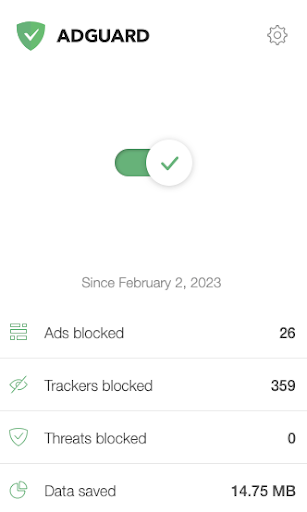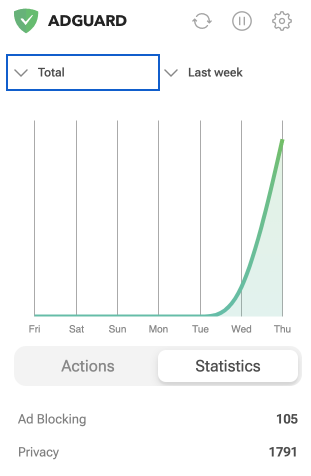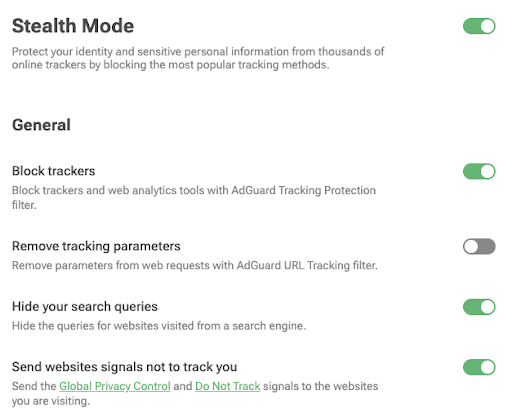-
Simple interface
-
Doesn’t interfere with device speed
-
Ad-blocking statistics can be hard to interpret
Advertiser Disclosure
All About Cookies is an independent, advertising-supported website. Some of the offers that appear on this site are from third-party advertisers from which All About Cookies receives compensation. This compensation may impact how and where products appear on this site (including, for example, the order in which they appear).
All About Cookies does not include all financial or credit offers that might be available to consumers nor do we include all companies or all available products. Information is accurate as of the publishing date and has not been provided or endorsed by the advertiser.
Editorial Policy
The All About Cookies editorial team strives to provide accurate, in-depth information and reviews to help you, our reader, make online privacy decisions with confidence. Here's what you can expect from us:
- All About Cookies makes money when you click the links on our site to some of the products and offers that we mention. These partnerships do not influence our opinions or recommendations. Read more about how we make money.
- Partners are not able to review or request changes to our content except for compliance reasons.
- We aim to make sure everything on our site is up-to-date and accurate as of the publishing date, but we cannot guarantee we haven't missed something. It's your responsibility to double-check all information before making any decision. If you spot something that looks wrong, please let us know.
AdGuard works efficiently to block ads without being intrusive. While opening various browser tabs, we noticed the number of blocked items steadily increased. That’s impressive, but we also had a bit of trouble navigating the interface, which we’ll discuss in further detail.
AdGuard is still a good ad blocker, and we tested it thoroughly to see how it performs with our Macbook Air while using two web browsers. Keep reading to learn how this ad blocker works and discover if AdGuard is the right ad-blocking software for your needs.
AdGuard features
AdGuard test results
Our AdGuard experience
AdGuard compatibility
AdGuard paid plan
AdGuard FAQs
Bottom line: Is AdGuard good?
AdGuard overview
| Ads blocked on Forbes homepage | 20/275 |
| Adblock-Tester score | 97/100 |
| Cover Your Tracks score | 2/3 |
| Does it block YouTube ads? | Yes |
| Compatibility | Google Chrome, Mozilla Firefox, Safari, Microsoft Edge, Opera, Yandex |
| Paid version | Starts at $2.49/mo |
| Details | Get AdGuard |
AdGuard pros and cons
- Easy to download
- Simple interface
- Doesn’t interfere with device speed
- If using multiple browsers, you must install the extension on each one
- Ad-blocking statistics can be hard to interpret
AdGuard features
AdGuard has impressive features like browsing security, parental controls, phishing protection, and Stealth Mode. It also comes with an Allowlist, which is AdGuard’s whitelist function. Here you can add specific websites that you don’t want AdGuard to filter. However, the Parent Control feature only works with Windows operating systems, so we weren’t able to test that option.
If you want more than just an ad blocker, AdGuard offers a virtual private network (VPN) and a cloud-based DNS service. These services can also be bundled at a discounted price. The DNS service is also great for parents because you can schedule screen time for your kids and block undesired content.
AdGuard doesn’t display warnings but it does show the number of ads blocked. You can also check a website’s security to ensure you’re on a safe site. That’s a great feature for when you’re using multiple websites and want to be secure.
One of the features that can be a bit confusing is the ad blocking and privacy section. You get a total number, but it’s not clear what that means. Even after thorough reading from AdGuard’s site, we couldn’t find an example that matched our extension window.
AdGuard test results
To test AdGuard, we used the AdBlock Tester and Cover Your Tracks. These are websites dedicated to testing browser protection and ad blockers. AdBlock Tester uses advertiser analytics to test the blocker’s effectiveness. Cover Your Tracks shows you an illustrated overview of how visible you are to online trackers. You will see the test scores in the table below.
AdGuard scores
| AdBlock Tester | Cover your Tracks | |
| AdGuard score | 97/100 | 2/3 |
Does AdGuard block YouTube ads?
If you want to block YouTube ads, you’ll love AdGuard’s blocking capabilities here. We tested numerous channels and videos and were pleasantly surprised when all the ads we normally see were blocked. AdGuard was effective at halting all advertisements while we watched the content of various videos.
We had no ads get through while watching, although we expected a few to slip through the cracks. That didn’t happen with our testing. Using AdGuard also didn’t change our user experience while watching YouTube videos. There were no speed disruptions or slowdowns noted.

Our AdGuard experience
Downloading and installing the ad blocker was no problem. The installation was quick and easy to set up. You may need to update your privacy settings to allow AdGuard access, but that’s simple to do.
In our testing, all the websites functioned properly and we didn’t notice any hiccups along the way. We were especially impressed with how it blocked ads while watching YouTube videos, as this is where tons of ads seem to populate. Having an ad blocker has allowed our internet usage to be more streamlined without the constant worry of trackers and ads getting through.
We downloaded AdGuard for our Mac and installed the AdGuard browser extension. To us, one of the best features is the data it saves. Since installation on our device, AdGuard has saved over 18 MB of data for the day.

As we mentioned, the one feature that can be confusing is the total number under AdGuard’s Ads blocked section. When you click on the Statistics option, you’ll see the number for Ad Blocking and then the number for Privacy. We aren’t sure how these numbers stack up or what they mean together.

However, we do like the phishing and malware protection functions that come with AdGuard. It’s a simple matter of turning the protection on, and you’re good to go.
You can also activate and remove context-based ads and websites that use self-promotion, which is a huge plus for ridding those internet interruptions. Also, Stealth Mode protects your identity and personal information from online trackers. We like the added bonus of being able to hide search queries, too.

AdGuard compatibility
If you’re looking for an ad blocker that’s compatible with almost any browser, you likely find that in AdGuard. The ad blocker works with the most popular web browsers. It also works on both Android and iOS devices. You can use Windows and macOS and enjoy AdGuard features. These are the browsers and systems that have AdGuard ad-blocking extension capabilities:
- Google Chrome
- Mozilla Firefox
- Opera
- Yandex
- Microsoft Edge
- Safari
- macOS
- Windows
- iOS
- Android
AdGuard paid plan
You can get the free version of AdGuard, but it also comes with the option of paid subscriptions. The paid versions allow protection across multiple platforms. With the Personal plan, you get coverage for up to 3 devices. If you choose the Family option, you get coverage for up to 9 devices. There isn’t a lot of information on the website that shows any other differences in the paid vs. free plan. If you only want coverage for one device, we recommend choosing the free option, but the paid plans are also reasonably priced.
AdGuard paid plan prices
| AdGuard Free | AdGuard Personal | AdGuard Family | |
| Price | Free | $2.49/mo | $5.49/mo |
| Block ads and pop-ups | |||
| Block trackers | |||
| Block site notifications | |||
| Block floating videos | |||
| Parental controls | |||
| Browsing Security | |||
| Stealth Mode | |||
| Details | View Plan | View Plan | View Plan |
AdGuard FAQs
Is AdGuard free?
AdGuard is a free download, but there are also paid plans offered that cover multiple platforms and devices.
Is AdGuard safe?
AdGuard is a safe third-party software, designed to block ads and improve your browsing experience. Since it’s open-source software, users can look at the coding to see if there are any security vulnerabilities.
AdGuard vs. AdBlock: Which is better?
AdGuard is better at blocking pages before they are loaded into the browser, thereby removing the ad elements. That may be due to AdGuard having an extension and stand-alone application. Since AdBlock is only an extension, it may not remove all the ads.
Does AdGuard sell your data?
According to their privacy policy, AdGuard does not sell your data.
What type of ads does AdGuard block?
AdGuard blocks all ads, including video ads, floating ads, pop-ups, banners, text ads, and interstitial ads.
Bottom line: Is AdGuard good?
AdGuard is a good ad blocker with plenty of features like phishing, tracking, and browser protection. When testing the product on our Macbook Air running Big Sur 11.3, we loved having multiple webpages open with no interruption in speed performance. Another standout feature is viewing YouTube videos with no ads invading while watching our favorite content creators.
AdGuard is best for the user who wants to get rid of online ads and likes to delve into all the functionality of the product interface. There are different options you can set up, like custom filters, an allowlist, and user rules. If you want to add your preferred filtering rules, you can do that with this ad blocker. It’s also a good product if you don’t want to pay a lot or anything at all for a solid ad blocker that takes care of annoyances in the background while you are web browsing.
-
Simple interface
-
Doesn’t interfere with device speed
-
Ad-blocking statistics can be hard to interpret
If you’re still looking for the best ad blocker for you, check out our Adblock Plus review.
-
Simple interface
-
Doesn’t interfere with device speed
-
Ad-blocking statistics can be hard to interpret






